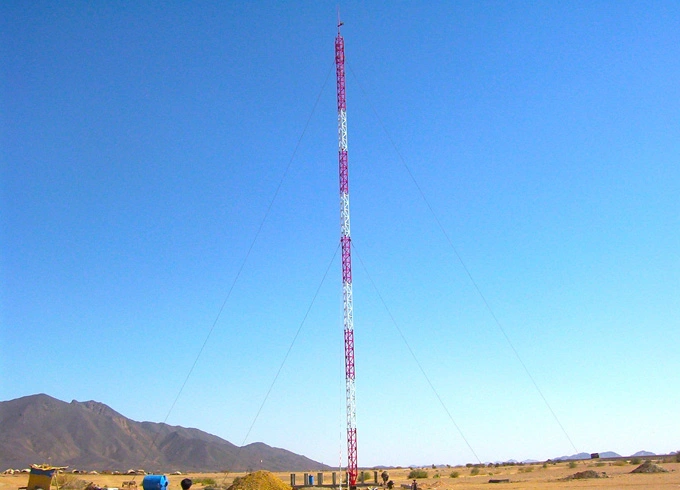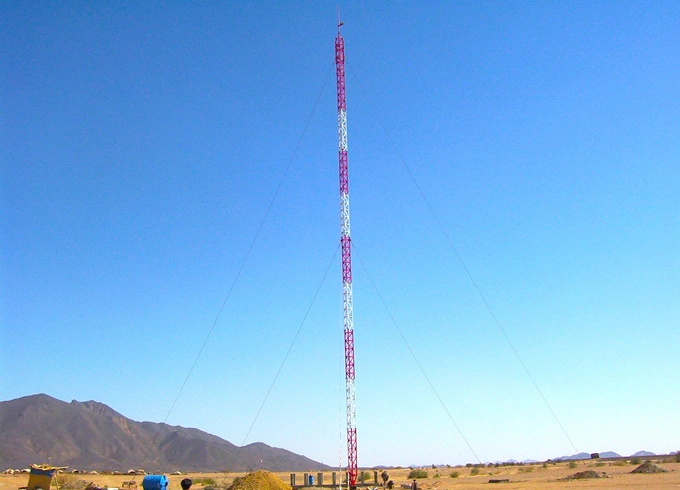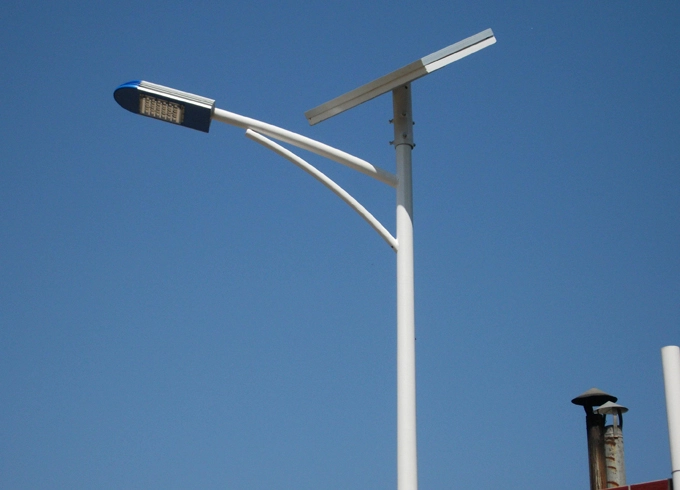Are dropped calls and slow internet frustrating you? Reliable connections depend on strong infrastructure. Guyed communication towers are a key part of that solution, reaching high to keep us linked. Guyed communication towers are vital structures using support cables (guy wires) anchored to the ground. They provide stable, high-reaching support for antennas, ensuring strong, reliable signals over long distances, which is crucial for today's communication networks. These towers might look simple, just a tall mast held up by wires. But their design is smart and serves a really important purpose in keeping our digital world running smoothly. Let's explore why these structures are so important and how they work. I think understanding this helps appreciate the technology behind our everyday connections.
Do you ever wonder how signals travel so far? Network expansion faces challenges. Guyed towers offer a practical way to extend reach and improve signal quality efficiently. Guyed towers are essential because they provide the height needed for broad signal coverage at a lower cost than self-supporting towers. This makes expanding reliable communication networks into various areas feasible.

Modern life demands constant connectivity. We need strong signals for phones, internet, and broadcasting. Guyed towers help meet these demands in several ways. At Junjiang Construction Co., Ltd., we see firsthand how critical these towers are. They allow antennas to be placed very high up. This height is key. Higher antennas mean signals can travel further without obstructions like buildings or hills getting in the way. This improves coverage, especially in rural or remote areas where building many smaller towers would be too expensive.
Building communication infrastructure is costly. Guyed towers offer a more affordable solution for achieving height compared to self-supporting towers, which need much larger, heavier bases.
| Feature | Guyed Tower Advantage | Impact on Networks |
|---|---|---|
| Height | Can be built very tall economically | Wider signal coverage area |
| Cost | Lower material & foundation costs | Makes network expansion affordable |
| Stability | Guy wires provide strong support | Reliable signal transmission |
| Foundation | Requires smaller concrete base | Less ground disturbance, lower cost |
The guy wires spread the load and anchor the tower securely. This makes them surprisingly stable, even in strong winds. I remember working on a project where a guyed tower stood firm through a major storm, ensuring essential communication lines stayed open. Their design efficiently balances height, cost, and stability, making them indispensable for many network builds.
Confused by different tower types? Some are freestanding, others use wires. A guyed tower uses supporting wires, which is its defining feature, making it distinct from other structures. A guyed communication tower is a tall, slender mast or lattice structure supported by multiple tensioned cables (guy wires) attached at various heights and anchored to the ground some distance away.

Think of a guyed tower like a tent pole held upright by ropes. The central mast handles the vertical load (compression), while the guy wires handle the sideways forces like wind (tension). This teamwork is what makes the design so effective.
Mast: This is the main vertical structure, often a lattice steel frame or a solid pole. It holds the antennas and other equipment.
Guy Wires: These are high-strength steel cables. They are attached to the mast at different levels and radiate outwards to ground anchors. The tension in these wires keeps the mast stable.
Anchors: These are strong foundations, usually concrete blocks buried in the ground, where the guy wires are securely fastened. The placement and strength of these anchors are critical.
Base Foundation: While the guy wires provide most of the stability, the mast still needs a foundation at its base to support its weight and transfer loads to the ground. However, this is usually much smaller than what a self-supporting tower of similar height would need. I recall visiting a site during the construction of a tall broadcasting tower. Seeing the massive anchor blocks being set and the precision needed to tension the guy wires really drove home how much engineering goes into these seemingly simple structures. It’s a balance of forces that allows them to reach impressive heights safely.
Choosing infrastructure involves many factors. Cost, height, and stability matter. Guyed towers excel in these areas, offering significant advantages for many communication projects. The key benefits of guyed towers include achieving great heights cost-effectively, requiring a smaller base foundation, providing excellent stability through guy wires, and generally having lower material costs than self-supporting towers.

Let's break down why these benefits are so important. At Junjiang Construction, we often recommend guyed towers when height and budget are major considerations.
Guyed towers can be built incredibly tall, sometimes exceeding 600 meters (about 2000 feet). This is much higher than is practical for most self-supporting towers. This height is crucial for applications like FM/TV broadcasting or long-distance microwave links, where maximizing line-of-sight is essential for signal range.
The design using guy wires significantly reduces the amount of steel needed for the main mast compared to a self-supporting tower of the same height. Self-supporting towers need a wide base and heavy structure to resist wind loads on their own. Guyed towers transfer these loads to the wires and anchors. This means:
Less steel = Lower material cost.
Smaller base foundation = Lower concrete and excavation costs. This makes guyed towers a very economical choice for reaching significant heights.
While the anchors spread over a large area, the actual base foundation is small. This can be an advantage in some terrains. The system of tensioned guy wires makes the tower very stable against wind and other environmental forces.
| Benefit | Description | Why it Matters |
|---|---|---|
| Height | Can reach extreme heights economically. | Maximizes signal coverage/range. |
| Cost | Lower material and foundation costs vs. self-supporting towers. | Makes tall infrastructure more affordable. |
| Stability | Guy wires provide excellent support against lateral forces. | Ensures reliable operation and safety. |
| Small Base | Central foundation is relatively small. | Can reduce site preparation complexity/cost. |
Ever driven through the countryside and seen tall, thin towers held by wires? These are often guyed towers. Their specific benefits make them ideal for certain locations and applications. The guyed communication towers are commonly used in rural areas for broadband and mobile coverage, for tall TV and radio broadcast antennas, and for long-distance microwave communication links where height is critical.
The unique characteristics of guyed towers dictate where they are most effective. We at Junjiang Construction steel tower factory have installed these towers in various settings, always leveraging their strengths.
Perhaps the most iconic use is for high-power television (TV) and frequency modulation (FM) radio broadcasting. These services need antennas placed extremely high to cover large geographical areas. Guyed towers provide the necessary height much more economically than self-supporting structures. Many of the tallest structures in the world are guyed broadcasting masts.
Expanding mobile phone and internet service into sparsely populated rural areas often requires tall towers for maximum reach per site. Land is usually more available and less expensive than in cities, making the larger total footprint (including anchor points) of a guyed tower acceptable. Their cost-effectiveness for height makes them a preferred choice here. I worked on a project bringing broadband to a remote valley; the guyed tower was essential to bridge the distance.
Point-to-point microwave communication requires a clear line of sight between dishes. Sometimes, this means needing very tall towers to overcome obstacles like terrain or the curvature of the Earth. Guyed towers provide a stable, tall platform for these links.
They can also be used for land mobile radio systems (like emergency services), measurement equipment (meteorological towers), and sometimes as part of cellular networks, especially for macro cells needing wide coverage. Their suitability depends on balancing the need for height, cost constraints, and land availability for the guy wire anchors.
Guyed communication towers are essential for modern connectivity. Their smart design provides great height affordably, ensuring reliable signals for broadcasting, rural internet, and more. They are a key part of our infrastructure. With over 15 years of experience in the industry, Junjiang’s Guyed Towers are engineered to meet international standards, ensuring long-lasting performance and reliable support for your communication infrastructure needs. Whether you are building in urban environments or remote locations, our towers are designed to meet your specifications and ensure seamless connectivity.
